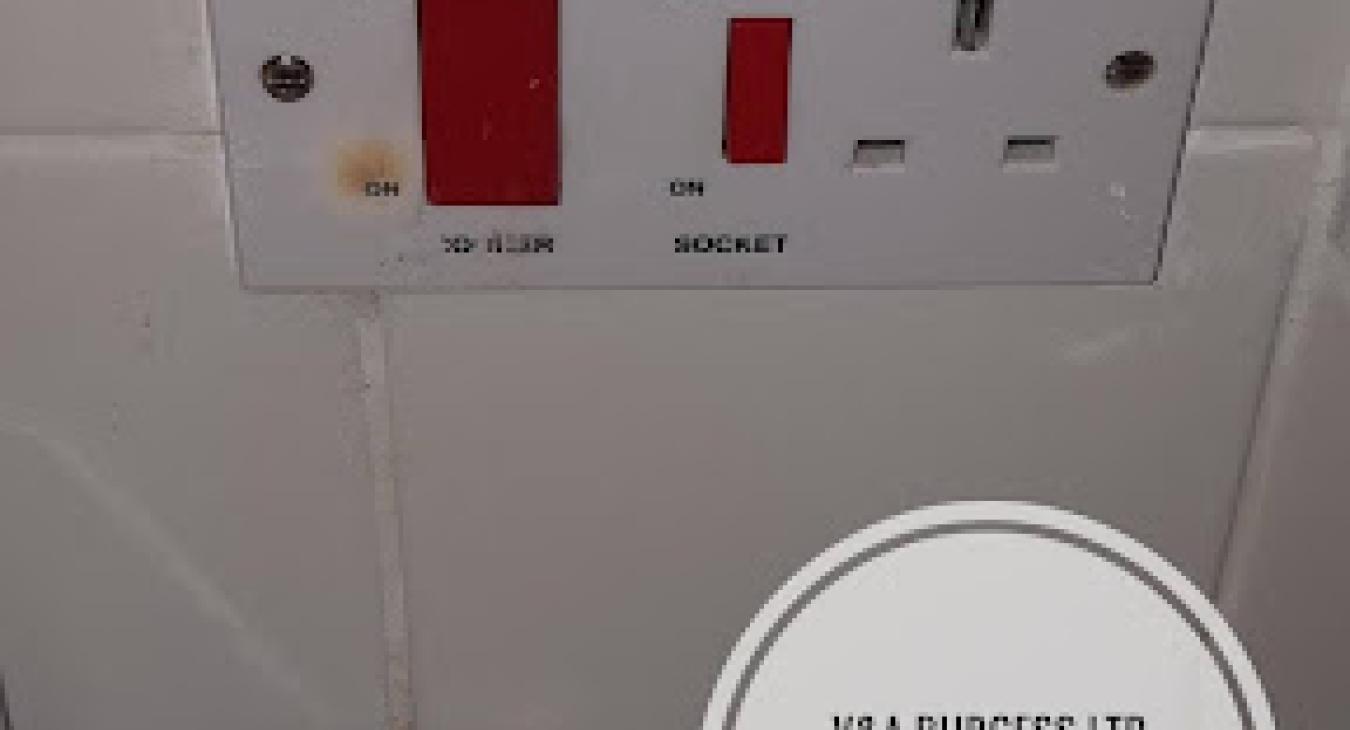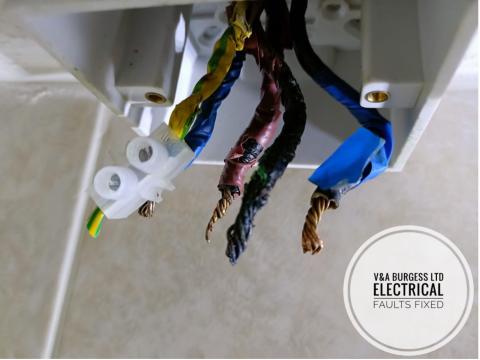
Table of Contents
- Why is my cooker switch stuck in the on position?
- Failed Internal Switch Mechanism
- Dirt or Debris Build Up in the Switch
- Burnt Out Connections and Heat
-
Common Questions on Cooker Switches
- What does a cooker switch do?
- How is a cooker switch wired?
- What size cable should I use for a cooker switch?
- Why does a cooker switch get stuck in one position?
- How Long does a cooker switch last?
- Can I use the cooker switch plug socket safely?
- Can I leave a cooker switch on?
- What rating should a cooker switch be?
- Can I change a cooker switch to a double socket?
- Can I disconnect a cooker myself?
- Why do cooker switches have a socket?
- Can I plug my electric cooker into a normal socket?
- Can a cooker and hob be on the same switch?
- Can you have a cooker isolator in a cupboard in 2024?
- Why does a cooker socket have two switches?
- Does a cooker switch need a light?
- Is it a legal requirement to have a cooker switch?
1) Why is my cooker switch stuck in the on position?
There can be several reasons why your cooker switch may be stuck in the on position and we will go through them in this article so you can decide the best solution for your problem.
- Failed Internal Switch Mechanism.
- Dirt or debris build up in the switch.
- Burnt out connections and heat.
2) Failed Internal Switch Mechanism
Inside every electrical switch there are moving parts that enable the electrical supply to be connected or disconnected through the switch. This connection forms the completion of the electrical circuit and provides power to the appliance or part of the circuit where it is required.
These switch mechanisms must, by their nature have moving parts in order that they can perform their function. Unfortunately, with time, movement, wear and tear these mechanisms can begin to either wear out or fail completely.
As a moving switch mechanism begins to wear, the connection it makes between the internal metal parts gets LOOSER and the resistance of the electrical joint gets HIGHER. This can create problems for the flow of electrical current and makes the whole junction heat up as electrical current struggles to get across the switch.
Eventually the heat will cause the connections to fuse, often aided with the melting of plastic gluing the whole lot together!! This can end with the COOKER SWITCH STUCK IN THE ON POSITION.
Back to top3) Dirt or Debris Build Up in the Switch
Kitchens can generate a lot of grease, dirt, and debris. These particles can make it into the switch mechanism over time despite how much you may clean your home. Once a sufficient level of debris has entered the switch and its mechanism, it will become difficult to switch off and will likely remain in the ON position.
Great care should be taken if considering cleaning the switch and as a rule, I would not advise doing this. If you were to attempt cleaning off the switch you must be careful to ensure that:
- The electrical supply is correctly and safely disconnected and that it is confirmed with a suitable GS38 tester
- That liquids don’t enter into the switch mechanism.
- The switch is suitably dry and has not been affected by the cleaning before re-establishing the supply to the switch!
In reality, the safest option is to have an electrician attend to investigate the issue for you, replace the switch if necessary and carry out any wiring repairs that may be apparently necessary following investigations.
Back to top4) Burnt Out Connections and Heat
Cooker switches, cables and in fact the whole electrical cooker circuit are often prone to failure in one way or another. This is because there is generally a high-power demand on these circuits combined with a lack of general maintenance in the form of professional inspection and testing. (https://www.electricalfaultsfixed.co.uk/blog/electrical-safety-check-list)
When these electrical connections loosen over time, they overheat. It is quite common for electrical connections to become loose during operation over several months or years. Electrical cables and electrical connections are all fabricated from metals. These metals are all different and will expand and contract as they heat and cool. They will also do this at different rates! This expansion and contraction combined with the vibration of supply frequency (yes really, its tiny but there) can cause electrical connections to loosen over time.
Back to top5) Common Questions on Cooker Switches
5.1) What does a cooker switch do?
A cooker switch provides an electric cooker, hob, or other appliance with isolation from the mains electrical supply such that the appliance can be safely worked upon, changed, or have maintenance carried out such as cleaning and repairs.
Cooker switches generally tend to offer ‘Dual-Pole’ isolation, that is, disconnection of BOTH the Line and Neutral conductors of the circuit and most appliance manufacturers now require that Dual Pole isolation is provided for their appliance with at least 3 mm of contact separation.
5.2) How is a cooker switch wired?
The incoming supply feed from the mains supply is fed into the relevant set of terminals on the rear of the cooker switch. These terminals can be marked as follows:
- IN
- SUPPLY
- FEED
- MAINS
The outgoing side of the cooker switch that feeds the electrical supply to the appliance has terminals that are often marked as follows:
- OUT
- LOAD
- APPLIANCE
If you are in any doubt as to the correct wiring for the cooker switch then there will be further guidance in the manufacturer’s instructions. An electrician should be contacted to carry out the replacement of a cooker switch as without the correct testing throughout the process the requirements of the wiring regulations BS7671 cannot be met.
5.3) What size cable should I use for a cooker switch?
Generally, most cooker circuits are a 6mm 6242Y cable from the consumer unit to the cooker switch. This is sometimes inadequate for really high-powered cookers and on occasion a 10mm cable will need to be installed.
There are diversity tables in the On-Site-Guide that allow the correct calculation of cable and circuit breaker sizes which should be followed at the design stage of any electrical installation work. Only an electrician should install a new electrical circuit as there are requirements that must be met that are nearly impossible to meet on a DIY basis.
5.4) Why does a cooker switch get stuck in one position?
The cooker switch will get stuck in one position when there has been excessive heat, dirt and debris ingress, loose connections, internal failure of the switch or undersized cabling used. When accompanied with a discolouration as seen in the photograph, it is likely that the cause is excessive heat and melted connections.
When a cooker switch is failing to turn off or on, it is no longer suitable for safe and continued use and should be changed by a suitably qualified person.
5.5) How Long does a cooker switch last?
Click offer a no quibble 20-year warranty on their Click Mode CMA054 cooker switch. They would not offer a warranty of this length if they were not certain that their product could not survive the period. This does of course assume that the warranty conditions are met which would need to be checked with the manufacturer.
5.6) Can I use the cooker switch plug socket safely?
Generally, there are no safety issues using the cooker switch plug socket. It has been designed such that the extra electrical load on the cooker switch and electrical circuit has been accounted for and there should be no safety issues using this socket.
Before using a cooker switch plug socket for the first time it is wise to perform a visual inspection of the plug socket. Check that the plug pin entry holes are not misshapen or discoloured. Check for discolouration around the switch itself and ensure that the switch for the socket turns off and on without any trouble.
5.7) Can I leave a cooker switch on?
Yes. In fact, you probably should. Most Ovens and Cookers come with a digital clock that is likely to continually lose its time if the cooker switch is turned off. The switch is primarily designed for the safe isolation of the appliance in the event of an emergency and where maintenance or repairs are needed.
Leaving a cooker switch on will NOT normally contribute to failure or overheating of the switch. Where a cooker switch has a neon light, these use virtually no power and are not likely to contribute significantly to the cost of your electricity bill.
5.8) What rating should a cooker switch be?
Most cooker switches are rated to 45 amps or 50 amps which is more than sufficient for even the most power of electrical cooker circuits. Many cooker circuits require only a 32-amp circuit breaker at the consumer unit and a 6mm electrical cable. Therefore a 45- or 50-amp cooker switch is more than large enough to cope with the electrical current that is likely to flow through.
5.9) Can I change a cooker switch to a double socket?
There are generally no issues with swapping a cooker socket over to a double plug socket. This overall physical dimensions of the frontal surface aspect are the same as a cooker switch. Care should be taken to ensure that the newly installed plug socket is not likely to lead to difficulty inserting plugs, fouling the work top of the kitchen or any other issues.
When swapping over a cooker switch for a double socket you must ensure that the double socket terminals are adequate to take the physical size of the cooker cable. One 6mm cable is generally fine although 2 6mm cables are likely not to fit safely.
5.10) Can I disconnect a cooker myself?
As long as the requirements of BS7671 wiring regulations are followed then electrical work can be carried out.
When disconnecting a cooker, one should consider how the end of the cable is going to be treated to ensure that access with live parts cannot occur. Simply not turning on the switch at the wall is UNACCEPTABLE and will at some point result in a serious accident involving electric shock.
If a cable is to be left connected to the cooker switch yet no cooker is to be installed, then the ends of the cables must be made safe, the cable secured correctly and measures taken to ensure that access to live parts cannot occur. If in doubt consult BS7671 or a qualified electrician.
5.11) Why do cooker switches have a socket?
Cooker switches are available with a socket so there can be an additional plug socket outlet in the kitchen for general use. This is quite a useful addition in the event of an electrical fault as the cooker tends to be supplied from the consumer unit on its own dedicated electrical circuit.
Should the main plug sockets circuit for the kitchen / house fail for whatever reason, the cooker has a spare plug socket that can be used to power a fridge freezer to prevent food spoiling whilst an electrician can check out the cause of the power failure.
When an electrical cooker circuit is being designed, the electrician considers if there is a cooker socket additional to the rest of the load on the circuit. This is added into the calculations for cable selection and diversity.
5.12) Can I plug my electric cooker into a normal socket?
Certain electrical cookers can be plugged into a normal plug socket. If in doubt, consult the manufacturers instructions for your specific product. Generally speaking, any cooker that is a double oven or oven and hob combined cannot be plugged in to a normal plug socket as there will not be enough power to safely run the appliance.
A typical oven has a 2 Kw (Kilowatt) element as a minimum, an electric hob requires around 4 Kw on during average use totalling 6 Kw of electrical demand.
An electrical plug socket can only safely supply 3 Kw for a short period and as such would be unsuitable for direct connection.
If the manufacturers instructions cannot be found then there may be a data badge on the appliance stating what is required in order to connect the appliance to the electrical supply. This should be consulted. If in any doubt, consult a qualified electrician or the store where the electric cooker was purchased.
5.13) Can a cooker and hob be on the same switch?
Yes, a cooker and hob can be on the same switch. Ideally there should be a means of turning off each appliance separately. Any junctions where the cable splits to go to each appliance should be accessible for maintenance and repair.
5.14) Can you have a cooker isolator in a cupboard in 2024?
Yes in 2024 you absolutely can have a cooker isolator in a cupboard as long as certain requirements of BS7671 are met. Such requirements would be compliance with regulations 132.12, 132.15.201, 134.1.1, 513.1, 537.3.3.6 AND 533.3.3.7.
If compliance with these regulations is met then a cooker switch can be installed in a cupboard. What does this mean? Well amongst other things, the equipment must:
- Remain Accessible
- Be easily maintainable
- Have sufficient spaces for safe operation, inspection, testing, maintenance, repair, and fault finding
- Be installed in a manner not likely to suffer mechanical damage, strain on connections or leaving access to live parts
5.15) Why does a cooker socket have two switches?
A cooker socket will have a Switch for the isolation of the live supply to the cooking appliance itself and a switch for the isolation of the plug socket. Each switch can be operated independently of the other.
5.16) Does a cooker switch need a light?
A cooker switch does not need to have a light under the wiring regulations. Many are sold without a light and this is absolutely fine. It is useful to have a light to allow you to realise when the cooker switches are in the on and off position more easily.
5.17) Is it a legal requirement to have a cooker switch?
No. The wiring regulations are non-statutory and therefore any non – compliance is not breaking the law necessarily. Serious and frequent deviations from the wiring regulations could lead to a contravention of EAWR1989 and as such could then be considered breaking the law.
There is no specific regulation referring to the isolation of cooking appliances in BS7671 at the time of writing but there are references to the construction of such isolation switches ‘cooker control units.
The manufacturers instructions should be consulted to ascertain the necessity of local cooker isolation and the version of BS7671 in force at the time. If dual pole isolation was required for example, then this could potentially be achieved by using the correct device at the consumer unit.
If the manufacturer specifically states that a cooker isolation switch should be fitted then according to the regulations, we “shall take account of manufacturer’s instructions” 134.1.1 BS7671.
It is a good idea to install a cooker switch locally to the appliance where possible and this should be the aim for every installation.
Back to top









